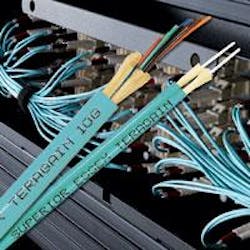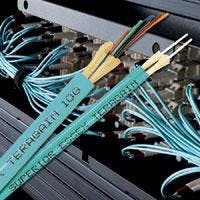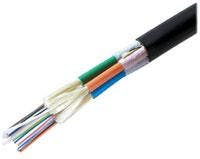Brushing up on multimode optical fiber
Choosing the right solution warrants a review of multimode fiber types and recent standards development.
The most common fiber used for premise and data center backbone cabling today is multimode. With several types and grades from which to choose, the challenge is selecting the most cost-effective solution while considering future bandwidth needs.
Understanding the features and benefits of the various multimode, and taking a look at current standards development, may ease your decision-making process-or, justify a delay in implementation.
Making the grade
While 850-nm laser-optimized (LO) 50-µm multimode fiber is defined by Gigabit Ethernet standards to support 10-Gbit Ethernet to 300 meters, some manufacturers are offering lower- and higher-grade versions. During the fiber manufacturing process, each spool of fiber is tested and graded based on differential mode delay (DMD) and effective modal bandwidth (EMB) measurements. (See sidebar, “A multimode refresher course,” page 42.)
“Normal process variations, such as temperature and pressure, can lead to variations in the chemical composition, which result in different grade fibers,” explains Andrew Oliviero, senior product manager for OFS (www.ofsoptics.com). “The majority of what's manufactured is in the middle at the 300-meter grade.”
Oliviero says higher-grade fibers require additional testing and more sophisticated processes, which puts costs at a premium: “There are constant efforts to improve the EMB of the fiber, and I think in time we'll see more of the higher-rated fiber being requested.”
OFS now offers three grades of its LO 50-µm multimode LaserWave fiber: 150, 300, and 550 meters.
“In terms of performance, it's simply the bandwidth that can be supported on a specific link length,” says Pete Weimann, R&D technical engineer from OFS. “It really depends on the application and what you're trying to achieve now and in the future. Having various grades of LO 50-µm multimode provides a new level of flexibility that makes sense for demanding applications.”
Superior Essex (www.supsx.com) also offers three different grades of LO 50-µm multimode fiber, with the 550-meter (m) as its latest TeraGain fiber offering (pictured above).
“If you don't need the distance, you can choose the economic 10G/150m fiber, but the 10G/550m fibers will possibly enable higher rates in the future,” says Paul Neveux, director for premises cable at Superior Essex. “The 10G/550m, however, is expensive and probably overkill in applications where distances are shorter.”
Beni Blell, fiber-optic product business manager for Berk-Tek (www.berktek .com), says the company’s GIGAlite fiber line represents a high performing 850-nm LO 50-µm multimode optical fiber. “About a year ago, we came out with a LO multimode fiber that has been DMD-verified for 10-Gbit Ethernet to 600 meters, which depending on the cable and fiber count can cost anywhere from 25 to 50 percent more,” says Blell. “We see a lot of this higher-grade fiber being installed in hospitals, universities, and financial institutions due to the enormous amounts of data, security, and back-ups.”
Sumitomo Electric Lightwave (www.sumitomoelectric.com) offers laser-optimized 50-µm fiber for 10-GbE operation for 300- and 500-meter distances in its air-blown fiber product line. “The choice of fiber grade depends on the topology of the campus and the distances from the hubs to the endpoints needing to be connectorized,” says Kurt Templeman, product manager for air-blown fiber in premises networks. “There is a cost differential that the customer must keep in mind when considering which grade is most appropriate for the application.”
Back to basics
Despite the shift to 50-µm multimode, well over 50 percent of the installed base remains legacy fiber distributed data interface (FDDI)-grade 62.5-µm multimode. For customers with that installed base, the main options for migrating to 10-Gbit Ethernet include rebuilding the network with 850-nm LO 50-µm multimode fiber or utilizing electronics with wavelength division multiplexing (WDM), specifically 10GBase-LX4 electronics.
“If I upgrade my network to 850-nm LO 50-µm multimode fiber, I can use less expensive 850-nm VCSEL-based 10GBase-SR electronics, which utilizes only one optical source,” explains Herb Congdon, global fiber product manager for Tyco Electronics/AMP Netconnect (www.ampnetconnect.com). “But if I want to use my legacy 62.5-µm multimode fiber beyond 26 meters for 10-Gigabit, I would have to use 10GBase-LX4 electronics, which utilizes WDM and four optical sources at 2.5 Gbits each-a much more expensive box. The question then is whether to spend more on cable and save on electronics, or save money by not recabling and spend more on the electronics.”
Replacing an entire fiber network with newer 850-nm LO 50-µm fiber can be disruptive and result in network downtime. Depending on the business, Congdon says, some customers will opt to upgrade to 10-Gbit using LX4 electronics, especially in situations where the fiber cannot be easily accessed and replaced.
The market need for running speeds beyond gigabit over legacy fiber gave rise to an IEEE (www.ieee.org) 802.3aq Study Group, which is investigating methods for running 10-Gbit Ethernet over 300 meters of FDDI-grade 62.5-µm multimode fiber with the use of one finely-tuned and controlled singlemode laser source. The proposed standard is the 10GBase-LRM (10-Gbit Ethernet over Long Reach Multimode), but its development has been slow.
“The difficulty with the LRM standard is the ability to cost-effectively reach the 300-meter benchmark for backbone cabling as defined under TIA standards,” says Congdon. “The intent of the standard is to come up with a solution cheaper than the LX4 option, which seems certain at 220 meters. But the concern is that if it won’t reach 300 meters, it may not have the necessary market acceptance. If the electronics end up no more cost-effective than LX4, it may not be worth finishing the standard.”
Although the standard is still in development, and may never even come to fruition, several electronics vendors are already claiming to have devices designed to meet the latest draft of IEEE 802.3aq 10GBase-LRM.
“We've seen a gradual reduction in 62.5-µm multimode fiber and an increase in the 50-µm, but we're very interested in what effect the 802.3aq LRM standard will have on the market," says Neveux of Superior Essex. “If it's a viable standard for 10-Gigabit, we could see 62.5-µm and 50-µm fiber sales becoming equal by around 2007.”
Customers with an installed base of 62.5-µm multimode fiber who wish to upgrade to 10-Gbit Ethernet might consider postponing upgrading until the standard is complete and they can weigh all their options.
Progress report
Apart from the marketing of various grades, multimode fiber is now stable in its technology, even as new trends in cable construction unfold and new standards loom on the horizon.
“Since there's not a lot of other new developments with fiber itself, manufacturers instead are concentrating on innovative methods for packaging and terminating the fiber,” says Congdon of Tyco Electronics/AMP Netconnect. “For example, we recently expanded our line of MTRJ-SECURE connectors to include 10 variants, and there's a definite push towards optical-fiber products for the data center environment.”
Tyco Electronics/AMP Netconnect offers its full line of modular plug-and-play optical-fiber trunk cables with MPO connectors, which terminate 12 fibers in a connector similar in size to one SC simplex connector.
“We're seeing a lot more interest in LO multimode cable that is indoor-outdoor rated,” says OFS' Wiemann. “In a campus situation, indoor-outdoor cable allows you to go from one building to another without a splice transition, which saves on labor, improves transmission, and offers better fiber management.”
Says Sumitomo’s Templeman, “The industry is also seeing an increasing trend among the enterprise to run predominantly zero or low-water-peak singlemode fiber for longer distance campus installations, and laser-optimized 50-µm multimode fiber supporting applications for distances up to 500 meters in its new buildings, preserving legacy 62.5-µm multimode for the horizontal run and fiber-to-the-desk applications.”
Interlocking armored optical-fiber cable is also getting some attention in the industry as an alternative to using innerduct. Its advantages include faster installation and crush and rodent resistance. Other recent trends include new materials aimed at meeting various standards and global initiatives (see "Get ready for 'green' initiatives from all corners," Cabling Installation & Maintenance, January 2006, page 42).
“We announced that, as of Jan. 1, 2006, all our fiber cables will be RoHS (Restriction of the use of Hazardous Substances)-compliant,” says Berk-Tek's Blell. “Over the past couple of years, the materials have evolved, and cable manufacturers today are able to extend the life of the cable and meet certain initiatives without impinging on performance.”
Congdon adds, “We may see changes coming out of the TIA 568-B revision process, but it's not yet determined what those will be, and I believe it will be more of a fine tuning on the fiber side. Discussions have begun surrounding 40-Gbit and 100-Gbit solutions, and although no project has yet started, I believe an IEEE study group is imminent.”
Congdon believes it will be difficult to achieve 40-or 100-Gbit on multimode without WDM or parallel optics technology. “It will be at least two years before anything on 40- or 100-Gigabit is published,” he predicts. “Singlemode fiber won't have a problem, but whether or not others will survive the process is yet to be determined.”BETSY ZIOBRON is a freelance writer covering the cabling industry, and a frequent contributor to Cabling Installation & Maintenance. She can be reached at: [email protected]
OFS offers AccuDRY indoor/outdoor cables, which use a proprietary buffering process designed to ensure a completely dry fiber cable without gels or flooding components.
A multimode refresher course
A decade ago, the industry standard for backbone fiber networks was the fiber distributed data interface (FDDI)-grade 62.5/12-µm multimode fiber with light-emitting diode (LED) transmitters operating at 1300 nanometers (nm), which most believed offered unlimited bandwidth for premise networks.
But as backbone speeds increased to Gigabit Ethernet, the LED signaling technology-which for years had been the low-cost, preferred transmission source-was no longer a viable solution because it could not be modulated (turned off and on) quickly enough. That, along with certain cost benefits, forced the industry to move to vertical-cavity surface emitting laser (VCSEL) technology.
Laser-based data transmission over multimode fiber experiences an effect called differential mode delay (DMD), which happens when a laser beam is launched into the fiber’s core, and the beam splits into several modes of light.
“The various modes of light travel at different speeds, reaching the receiver at different times and causing reduced transmission capacity,” explains Paul Neveux, PHD, director of product management for premises cable at Superior Essex. “The longer the distance and higher the speed, the more the pulses will separate. At gigabit speeds or higher, the light pulses can spread out so much that the receiver can't tell if the pulse is on or off.”
Because a smaller fiber core has fewer modes of light excited and less distortion, 50-µm multimode fiber is able to transmit light signals for longer distances than the larger-core 62.5-µm fiber. This, combined with the release of the Gigabit Ethernet standard, caused an industry shift towards 50-µm fiber.
As the 10-Gbit Ethernet standard developed, fiber makers began manufacturing 850-nm laser-optimized (LO) 50-µm fiber to reach the “sacred” 300-meter distance. This type of multimode fiber, which is produced with alterations to the index of refraction profile, limits the DMD and provides a minimum 2,000 MHz-km bandwidth for 850-nm VCSELs.
Today, 850-nm LO 50-µm multimode fiber is becoming the recommended cable for new installations and upgrades, but 62.5-µm multimode is still alive and well.
“Many continue to install 62.5-µm fiber,” says Herb Congdon, global fiber product manager for Tyco Electronics/AMP Netconnect. “It's a good fiber and relatively inexpensive, and if they know they're not going to need to run 10-Gigabit more than 26 meters, it works just fine. And, when adding fiber to an existing 62.5-µm fiber network, people don't often want to mix fiber types; so, they stick with what they have.”
Congdon concludes, “850-nm LO 50-µm multimode fiber is certainly what we would recommend customers install today, but it isn't necessarily the only solution.”-BZ
Multimode fiber manufacturers
Information taken from the 2006 and 2005 Cabling Installation & Maintenance Buyer’s Guide.
ADC
Minneapolis, MN
(952) 938-8080
www.adc.com
APA Cables & Networks
Plymouth, MN
(763) 476-6866
www.apacn.com
Belden CDT Electronics Division
Richmond, IN
(765) 983-5200
www.belden.com
Berk-Tek
New Holland, PA
(717) 354-6200
www.berktek.com
CommScope
Hickory, NC
(800) 982-1708
www.commscope.com
Components Express Inc.
Woodridge, IL
(630) 257-0605
www.componentsexpress.com
Condumex Wire and Cable
Grand Prairie, TX
(972) 352-2300
www.condumex.com
Sumitomo Electric Lightwave
Research Triangle Park, NC
(800) 358-7378
www.sumitomoelectric.com
Superior Essex
Atlanta, GA
(770) 657-6000
www.superioressex.com
SYSTIMAX Solutions
Richardson, TX
(800) 344-0223
www.systimax.com
3M Communication Markets Division
Austin, TX
(800) 426-8688
www.3m.com/enterprise
Tri-Net Technology Inc.
Walnut, CA
(909) 598-8818
www.trinetusa.com
TRT Business Network Solutions Inc.
Costa Mesa, CA
(714) 564-7777
www.trtinfo.com
Tyco Electronics/AMP Netconnect
Harrisburg, PA
(800) 553-0936
www.ampnetconnect.com
Woodhead Industries Inc.
Northbrook, IL
(847) 272-7990
www.woodhead.com
Sumitomo Electric Lightwave
Research Triangle Park, NC
(800) 358-7378
www.sumitomoelectric.com
Superior Essex
Atlanta, GA
(770) 657-6000
www.superioressex.com
SYSTIMAX Solutions
Richardson, TX
(800) 344-0223
www.systimax.com
3M Communication Markets Division
Austin, TX
(800) 426-8688
www.3m.com/enterprise
Tri-Net Technology Inc.
Walnut, CA
(909) 598-8818
www.trinetusa.com
TRT Business Network Solutions Inc.
Costa Mesa, CA
(714) 564-7777
www.trtinfo.com
Tyco Electronics/AMP Netconnect
Harrisburg, PA
(800) 553-0936
www.ampnetconnect.com
Woodhead Industries Inc.
Northbrook, IL
(847) 272-7990
www.woodhead.com


